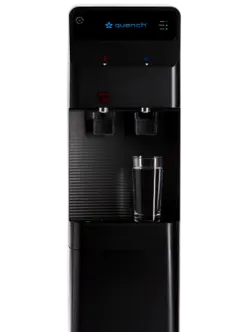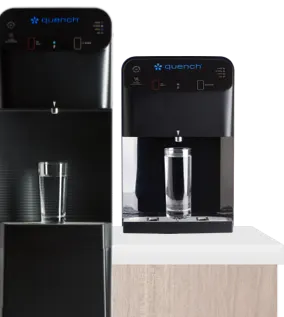Plastic is all around us, and whether you’re at home or in your workplace, you’re likely surrounded by it. What many people may not realize is that most plastic takes anywhere from 100 to 400+ years to break down, according to the Environmental Protection Agency. And when plastic eventually degrades, it doesn’t simply disappear. Instead, it transforms into tiny versions of itself called microplastics, thanks to environmental factors like ultraviolet (UV) radiation from the sun and ocean waves.
Scientists have discovered microplastics in practically every corner of the world and most bodies of water, including in drinking water sources like lakes, rivers, and groundwater. It’s, therefore, no surprise that traces of plastic are now showing up in humans and animals as well.
The good news is you’re not defenseless against microplastics in your drinking water. Read on to discover more about this growing issue and learn how to prevent these tiny plastic particles from entering your water supply.
What Are Microplastics?
Microplastics are defined as mini plastic particles less than five millimeters (5,000 microns) in diameter, and these tiny particles are divided into two categories:
1. Primary Microplastic Particles
Primary microplastics, often called microbeads, are intentionally manufactured and are key ingredients in scrubs, hand-washing soaps, cleansers, toothpaste, and biomedical products. The National Ocean Service reports these plastic microbeads are typically made of polypropylene (PP), polystyrene (PS), or polyethylene (PE). As early as 2015, several countries banned microbeads from rinse-off cosmetics including Canada, France, India, New Zealand, Sweden, Taiwan, and the United Kingdom. By 2020, Ireland, Italy, India, and Thailand all introduced bans as well, according to a report from Sidley — which is paving the way for more to follow.
2. Secondary Microplastics
Secondary microplastics are created through the breakdown of any piece of plastic litter — including a plastic bottle, plastic bag, plastic straw, plastic container, and more. UV radiation from the sun and natural forces from the environment inevitably work together to break plastic waste down into smaller versions of itself, according to Nature.
Unfortunately, microplastics have become pervasive environmental contaminants. Originating from the breakdown of larger plastic items or entering the environment as microscopic particles, they’re now a growing problem affecting coastal communities, marine ecosystems, aquatic life, and human health, according to the National Centers for Environmental Information (NCEI). In fact, research reveals that plastic materials represent between 60% and 80% of the waste present in the marine environment and 90% of the waste floating on the seas and oceans. What’s more, at least 267 species worldwide are affected as a result — including 44% of birds, 43% of mammals, 86% of turtles, and various fish species. The growing ubiquity of microplastic fibers and particles is emphasizing the urgent need for sustainable practices to curb their escalating growth.
How Do Microplastics Get Into Drinking Water?
Microplastics enter tap water and drinking water in various ways. The two main sources of microplastic pollution in drinking water are surface run-off (e.g., after a rain event) and wastewater effluent (i.e., water that flows out of a treatment plant, sewer, or industrial outfall). According to the World Health Organization, fewer overflows, industrial waste, degraded plastic waste, and atmospheric deposition — when gases move from the atmosphere to the Earth’s surface — can also result in microplastics in drinking water.
Moreover, these microplastics are now pervasive in tap water. Despite conventional water treatment regulations, a study from Orb Media tested water samples from more than a dozen nations and found that 83% of the samples were contaminated with plastic fibers. It was also discovered that the United States had the highest contamination rate, with 94% plastic fibers found in the sampled tap water.

Microplastics in Bottled Water
For those aiming for clean drinking water, whether at home or in your workplace, you might be considering swapping your tap for bottled water. But not so fast! Take a closer look beyond the plastic water bottle label, and you’ll discover tiny particles of plastic floating inside.
Numerous studies indicate that individuals who consume bottled water end up ingesting more microplastics than those who opt for tap water. An eye-opening study published in Frontiers in Chemistry analyzed water from 259 bottles sold across multiple countries, revealing that a staggering 93% of them contained microplastics — some even visible to the naked eye! This means that relying on bottled water or hefty gallon jugs may not be the best drinking water solution.
Despite all the evidence that shows microplastics are ubiquitous in bottled water, a 2021 Culligan Global World Water Day Survey, conducted by Toluna, revealed that 1/3 of respondents believe bottled water doesn’t contain microplastics and another 32% don’t know whether it does — making it essential to keep in mind moving forward.
The Impact of Microplastics on Your Health
According to doctors from the Harvard T.H. Chan School of Public Health, various types of plastics contain a range of chemicals with different properties, such as plasticizers, antioxidants, and colorants. Many of these chemicals found in tiny plastic particles are concerning because long-term exposure has been shown to have negative effects on health. Phthalates and bisphenol A (BPA) are particularly troubling substances found in numerous plastics, acting as endocrine disruptors that interfere with hormone activity.
Researchers have found a correlation between plastic chemicals and adverse health outcomes, including:
- Obesity
- Diabetes
- Heart disease
- Cancer
- Neural disorders
- Reproductive problems
It’s clear that leveraging drinking water solutions that contain microplastics leads to considerable potential health effects. This ultimately impacts your overall well-being and productivity, both at home and at work. As a result, individuals and organizations alike are increasingly turning to alternative water sources that are cleaner and more likely to drive hydration.
4 Ways to Avoid Microplastics
Microplastic exposure is becoming increasingly difficult to prevent, especially when it comes to your drinking water sources. We’re exploring a few important actions you can take to minimize the chances of microplastic contamination in your drinking water:
1. Invest in a Reliable Filtration System
The best way to protect yourself against harmful plastic particles is to opt for a high-quality water filtration system equipped with advanced technologies like reverse osmosis (RO). These systems effectively sieve out microplastics, so you can rest assured that you’re enjoying a clean and plastic-free drinking water solution. Consider models with multi-stage filters — such as a Quench Q-Series water cooler that produces quenchWATER+ — for enhanced efficiency and results.
2. Choose Distilled Water Options
Distilled water undergoes a purification process involving vaporization and condensation. As a result, the Safe Drinking Water Foundation reports that distillation filters can generate around 99.9% pure distilled water — effectively filtering out 100% of known microplastics. While relying on distilled water is a dependable approach to minimizing microplastic presence in your drinking water, purchasing it in plastic bottles will still introduce microplastics — making it crucial to use a filtration system for this alternative.
3. Minimize Your Use of Single-Use Plastic
Microplastics often originate from the breakdown of larger plastic items. By simply reducing your use of single-use plastics like water bottles, gallon jugs, and other containers, you contribute to a decrease in plastic waste that could eventually end up in water sources. You can take simple steps to achieve this, like opting for reusable alternatives such as stainless steel or glass containers.
4. Stay Informed About Your Local Water Sources
Remember, that local water quality can change from zip code to zip code. This means it’s essential to be aware of the water sources in your area and stay informed about water quality reports. You can also work with our nationwide Quench Water Experts to ensure you’re prepared to make informed decisions about your water consumption.
The Advantages of a Cleaner Water Supply
Opting for a water supply that minimizes the risk of prolonged exposure to microplastics in your community, whether at home or in your workplace, can bring about several advantages. Here are just some of the many benefits of cleaner drinking water:
- Supporting your long-term health and well-being, as a result of improved hydration levels.
- Driving water consumption habits that mitigate the risks of dehydration.
- Helping you achieve your full potential by ensuring you feel your best.
- Enhancing your focus, energy levels, and mental clarity throughout the day, which is directly linked to the rise in your daily water intake.
- Mitigating plastic pollution and elevating your sustainability efforts by minimizing your reliance on single-use plastic.
- Boosting your productivity and efficiency in all aspects of your life.
Protect Yourself From Microplastics With a Bottleless Water Cooler From Quench
You can take proactive steps to minimize the amount of plastic you ingest daily: Say no to bottled water, cut down on plastic waste and plastic pollution, and enjoy clean, delicious filtered water with one machine — a bottleless water cooler from Quench.
Quench filtered water coolers cater to businesses, acting as a shield against harmful water contaminants while also combating environmental issues related to plastic waste and carbon emissions. A Quench Q-Series water cooler that makes quenchWATER+ with reverse osmosis (RO) filtration can act as a defense against microplastics in drinking water. The RO technology in Quench Q-Series water coolers features a 5-filter setup, including:
- A sediment filter removes anything larger than 10 microns.
- A pre-carbon filter that removes anything larger than 5 microns.
- An RO filter that pushes molecules through a semipermeable membrane of pore size 0.0001 microns against its natural concentration gradient.
Since microplastics are less than 5000 microns, RO filters like the ones featured in Quench Q-Series water coolers can effectively remove most microplastics larger than 0.0001 microns from your tap water. The quenchWATER+ filtration system even adds back hydrating minerals like sodium, potassium, magnesium, and calcium — so you can rest assured it tastes great, too.
If you aren’t familiar with the micron measurement, check out our quenchWATER+ filtration chart below for size reference.

Minimizing your plastic intake also involves cutting down on your plastic output. Plastic usage is prevalent not only in workplaces but also in homes, and a Quench filtered water cooler provides an excellent plastic-free solution for individuals looking to lessen their environmental impact in a variety of settings. Remarkably, just one Quench water cooler can keep 7,000 plastic bottles and 150 plastic jugs out of the environment every year. By reducing your overall plastic consumption, you contribute to fewer microplastics in water, food, and the air — ultimately resulting in fewer microplastics in your body.
Explore our range of bottleless water dispensers or try our product finder to discover the machine that’s right for your needs. Once you’re ready for delicious, clean water with fewer microplastics, you can get a free estimate to get started.
Did you get all that? Take our quiz below to test your knowledge about microplastics in drinking water.










